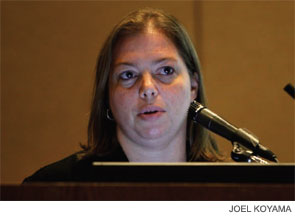
Minneapolis, Minn.—For patients undergoing surgery, identification of known or suspected obstructive sleep apnea (OSA) is critical to avoid or minimize surgical complications that are increased in these patients, experts said here last month at SLEEP 2011, the 25th Annual Meeting of the Associated Professional Sleep Societies.
Tracey Stierer, MD, medical director at the Johns Hopkins Medicine Outpatient Center, director of the division of ambulatory anesthesia and assistant professor of anesthesiology and critical care medicine at Johns Hopkins University in Baltimore, discussed the importance of screening surgical patients for OSA. She used the 2006 practice guidelines by the American Society of Anesthesiologists (ASA) as the template for her talk (Anesthesiology. 2006;104(5):1081-1093). Although the guidelines are not evidence-based, she said they provide a starting point to draw attention to the need to screen surgical patients for OSA and may provide some help on specific issues.
Among these issues is a way to score the severity of OSA to determine the risk of increased postoperative morbidity and mortality, along with the appropriate post-care location. The guidelines, for example, strongly recommend against sending to an unmonitored environment any patient who has had airway surgery, has a history of OSA or is suspected to have OSA.
In patients with known or suspected OSA, Dr. Stierer recommended that surgery be scheduled early in the day to allow for ample postoperative observation time. She also emphasized the importance of communication between the anesthesia and surgical teams to determine the approach to airway management and postoperative disposition. “Specifically, those patients with other co-morbidities such as overlap syndrome, pulmonary hypertension or compensated heart failure might be better served in an inpatient venue as opposed to an ambulatory surgical center,” she said.
Dr. Stierer also discussed an algorithm that has been used by Johns Hopkins Hospital in Baltimore, Md., for the past 15 years to determine postoperative care for OSA patients. Dr. Stierer, for example, has her patients who have previously been treated with continuous positive airway pressure (CPAP) bring their CPAP devices to the hospital on the day of surgery so they can use the devices postoperatively. For patients unable to use CPAP on the first night because of the nature of the surgical procedure, she urged high-level postoperative observation in an intensive care setting.
Another issue, is the need to maintain a high level of vigilance for obstruction in the immediate postoperative period. If a patient has been prescribed an oral narcotic to use at home after surgery, she said, Johns Hopkins physicians typically administer the first dose before discharge so they can observe the patient and determine fitness for discharge to home or an unmonitored environment.
Children with OSA
Stacey Ishman, MD, MPH, director of the Center for Snoring and Sleep Surgery at Johns Hopkins Hospital, said that the most critical advance in pediatric sleep medicine has been the recognition that OSA occurs frequently in children. Data suggest that chronic snoring occurs in 5 to 12 percent of children and that about 2 percent have overt OSA on a sleep study, she said. Although OSA is commonly seen in children who are underweight and failing to thrive, Dr. Ishman emphasized current findings that persistent OSA is most common in overweight children.
For diagnosis, she highlighted diagnostic criteria included in the Academy of Pediatrics (AAP) 2002 guidelines, “Clinical Practice Guideline: Diagnosis and Management of Childhood Obstructive Sleep Apnea Syndrome.” These include the need to screen all children for snoring, along with further screening in snorers to determine if the snoring is OSA-related.
For treatment, Dr. Ishman highlighted two key recommendations in the AAP guidelines: The first one recommends that high-risk patients be monitored as inpatients after surgery and the second that patients be re-evaluated after surgery to determine if additional treatment is required. For children considered at significantly increased risk (i.e., those with a score of 5 or more), it is recommended that elective surgery such as T&A be postponed; if T&A is performed on these children, it should not be handled at an outpatient facility.
“The most important thing for otolaryngologists to keep in mind is that treatment by adenotonsillectomy of children even with mild OSA can provide significant benefit and that removal of even small tonsils can be curative,” Dr. Ishman said.
Leave a Reply